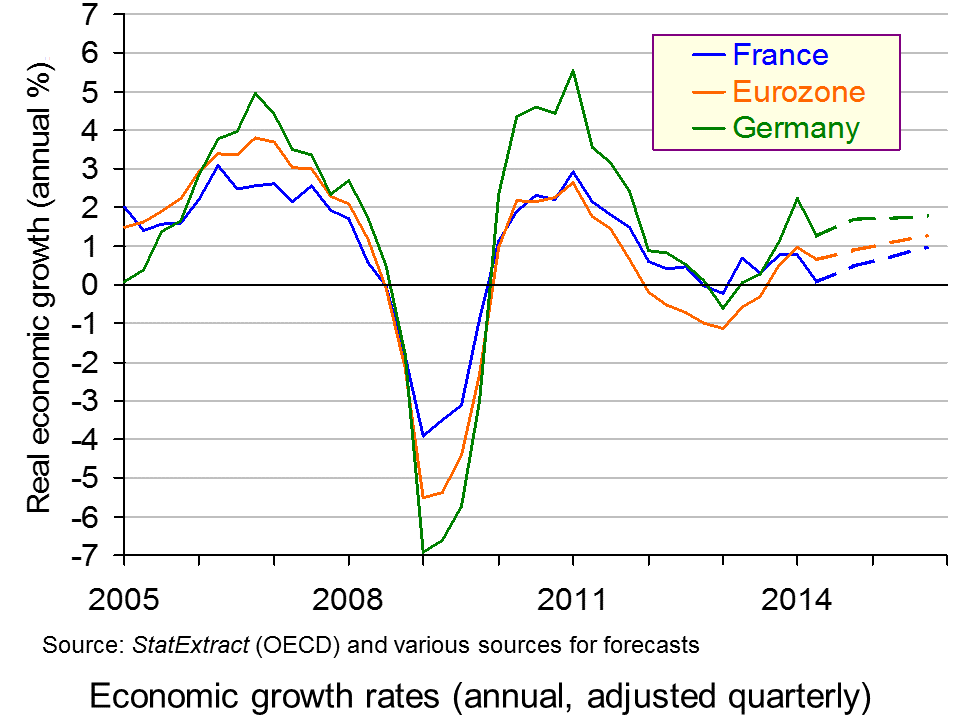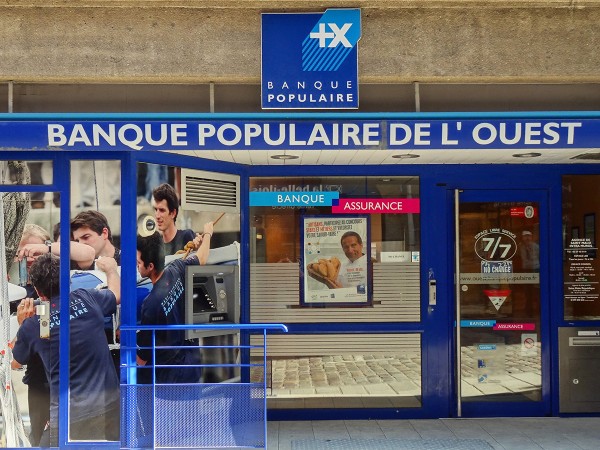 Now here’s a gloomy article from Robert Peston. He’s been looking at investors’ views about the coming years and sees a general pessimism about the prospects for long-term economic growth. And that pessimism is becoming deeper.
Now here’s a gloomy article from Robert Peston. He’s been looking at investors’ views about the coming years and sees a general pessimism about the prospects for long-term economic growth. And that pessimism is becoming deeper.
It is true that both the UK and the USA have recorded reasonable growth rates in recent months and do seem, at least on the surface, to be recovering from recession. But, according to investor behaviour, they:
seem to be saying, in how they place their money, that the UK’s and USA’s current reasonably rapid growth will turn out to be a short-lived period of catch-up, following the deep recession of 2008-9.
So what is it about investor behaviour that implies a deep pessimism and are investors right to be pessimistic? The article explores these issues. It does also look at an alternative explanation that investors may merely be being cautious until a clearer picture emerges about long-term growth prospects – which may turn out to be better that many currently now predict.
The article finishes by looking at a possible solution to the problem (if you regard low or zero growth as a problem). That would be for the government to ‘throw money at investment in infrastructure – to generate both short-term growth and enhance long-term productive potential.’
Note that Elizabeth also looks at this article in her blog The end of growth in the west?.
The end of growth in the West? BBC News, Robert Peston (26/9/14)
Questions
- What is meant by the ’25-year yield curve for government bonds’? Why does this yield curve imply a deep level of business pessimism about the long-term prospects for UK economic growth?
- What are the determinants of long-term economic growth?
- Looking at these determinants, which ones suggest that long-term economic growth may be low?
- Are there any determinants which might suggest that economic growth will be maintained over the long term at historical levels of around 2.6%?
- Do demand-side policies affect potential GDP and, if so, how?
- What policies could government pursue to increase the rate of growth in potential GDP?
- What current ‘dramas’ affecting the world economy could have long-term implications for economic growth? How does uncertainty about the long-term implications for the global economy of such dramas itself affect economic growth?
- Is long-term growth in real GDP an appropriate indicator of (a) economic development and (b) long-term growth in general well-being?
 The growth rates of the Western world have been somewhat volatile for the past decade, with negative growth sending economies into recession and then varying degrees of economic recovery. Growth rates elsewhere have been very high, in particular in countries such as China and India. The future of economic growth in the west is hotly debated and whether the western world has been forever changed by the credit crunch remains to be seen.
The growth rates of the Western world have been somewhat volatile for the past decade, with negative growth sending economies into recession and then varying degrees of economic recovery. Growth rates elsewhere have been very high, in particular in countries such as China and India. The future of economic growth in the west is hotly debated and whether the western world has been forever changed by the credit crunch remains to be seen.
The article below from the BBC, written by Robert Peston, the Economics Editor, addresses the question of the future of the western world. Opinions differ as to whether the west is finally recovering from the recession and financial instability or if the credit crunch and subsequent recession is just the beginning of many years of economic stagnation. The article in particular focuses on the yield curve and the trends in government debt or gilts. This tends to be a key indicator of the expectations of the future of an economy and how confident investors are in its likely trajectory. Though technical in places, this article provides some interesting stances on what we might expect in the coming 2-3 decades for economic performance in the West.
Note that John also looks at this article in his blog Cloudy Skies Ahead?
The end of growth in the West? BBC News, Robert Peston (26/9/14)
Questions
- Which factors affect the economic growth of a nation?
- Confidence from consumers, firms and investors is always argued to be crucial to the future economic growth and in many cases, the recovery of an economy. Explain why this factor is so important.
- What is the yield curve and what does it show?
- How can the yield curve be used to offer predictions about the future strength of an economy?
- Why are governments seen as the safest place to lend?
- If Larry Summers is correct in saying that it is a negative equilibrium interest rate that is needed to generate full employment growth, what does this suggest about the future economic performance of the western world?
- In the article, there is a list of some of the key things that make investors anxious. Review each of these factors and explain why it is so important in generating anxiety.
 One of the key prices in any economy is that of oil. Whenever oil prices change, it can have a knock-on effect on a range of other markets, as oil, or some variation, is used as an input into the production of countless products. The main products that consumers will see affected are energy prices and petrol prices..
One of the key prices in any economy is that of oil. Whenever oil prices change, it can have a knock-on effect on a range of other markets, as oil, or some variation, is used as an input into the production of countless products. The main products that consumers will see affected are energy prices and petrol prices..
Although on the supply-side, we see a large cartel in the form of OPEC, it is still the case that the forces of demand and supply directly affect the market price. Key things such as the demand for heating, economic growth, fears of war and disruption will change the demand and supply of oil. The possibility of militant strikes in oil producers, such as Syria, would normally reduce supply and push up the market price. However, we have actually seen oil prices drop much faster than we have in two years, dropping below $100 per barrel since September 5th. The slowdown of economic growth in Asia, together with the return of Libyan production at a level greater than expected have helped to push prices down and have offset the fears of global production.
 The market forces pushing prices down, while good for consumers and firms that use crude oil or one of its by-products, are clearly bad for oil producers. (Click here for a PowerPoint of the chart.) Countries are urging OPEC to halt its production and thereby shift supply upwards to the left putting a stop to the downward oil price trend. Several countries are concerned about the impact of lower prices, and one country that may be significantly affected is Russia. Some are suggesting that the impact could be as big as 4% of Russia’s GDP, taking into account the ongoing political crisis with Ukraine.
The market forces pushing prices down, while good for consumers and firms that use crude oil or one of its by-products, are clearly bad for oil producers. (Click here for a PowerPoint of the chart.) Countries are urging OPEC to halt its production and thereby shift supply upwards to the left putting a stop to the downward oil price trend. Several countries are concerned about the impact of lower prices, and one country that may be significantly affected is Russia. Some are suggesting that the impact could be as big as 4% of Russia’s GDP, taking into account the ongoing political crisis with Ukraine.
The market for oil is highly susceptible to changes in both demand and supply-side factors. Microeconomic changes will have an impact, but at the same time any global macroeconomic factors can have significant effects on the global price. Expectations are crucial and as countries release information about the size of the oil stocks and inventories, it is adding to the downward pressure on prices. Some oil experts have predicted that prices could get as low as $80 per barrel before OPEC takes significant action, influenced heavily by countries like Saudi Arabia. The following articles consider this global market.
Articles
Iran urges OPEC to halt oil price slide Financial Times, Anjli Raval (26/9/14)
Oil overflow: as prices slump, producers grapple with a new reality The Globe and Mail, Shawn McCarthy and Jeff Lewis (27/9/14)
Weak demand, plentiful supply drive decline in oil prices International Distribution (26/9/14)
Oil prices plunging despite ISIS CNN Money, Paul R La Monica (25/9/14)
Oil prices fall on EIA report of big U.S. crude stocks build Reuters, Robert Gibbons (17/9/14)
Sanctions and weaker oil prices could cost Russia 4% of GDP – official RT (25/9/14)
Data
Spot oil prices Energy Information Administration
Weekly European Brent Spot Price Energy Information Administration (Note: you can also select daily, monthly or annual.)
Annual Statistical Bulletin OPEC
Questions
- What are the key factors on the microeconomic side that affect (a) demand and (b) supply of oil?
- Explain the key macroeconomic factors that are likely to have an impact on global demand and supply of oil.
- Militant action in some key oil producing countries has caused fears of oil disruption. Why is that oil prices don’t reflect these very big concerns?
- Use a demand and supply diagram to explain the answer you gave to question 3.
- What type of intervention could OPEC take to stabilise oil prices?
- Why is the Russian economy likely to be adversely affected by the trend in oil prices?
- Changes in the global macroeconomy will directly affect oil prices. Is there a way that changes in oil prices can also affect the state of the global economy?
 The French economy is flatlining. It has just recorded the second quarter of zero economic growth, with growth averaging just 0.02% over the past 12 months. What is more, the budget deficit is rising, not falling. In April this year, the French finance minister said that the deficit would fall from 4.3% in 2013 to 3.8% in 2014 and to the eurozone ceiling of 3% in 2015. He is now predicting that it will rise this year to 4.4% and not reach the 3% target until 2017.
The French economy is flatlining. It has just recorded the second quarter of zero economic growth, with growth averaging just 0.02% over the past 12 months. What is more, the budget deficit is rising, not falling. In April this year, the French finance minister said that the deficit would fall from 4.3% in 2013 to 3.8% in 2014 and to the eurozone ceiling of 3% in 2015. He is now predicting that it will rise this year to 4.4% and not reach the 3% target until 2017.
The deficit is rising because a flatlining economy is not generating sufficient tax revenues. What is more, expenditure on unemployment benefits and other social protection is rising as unemployment has risen, now standing at a record 10.3%.

And it is not just the current economic situation that is poor; the outlook is poor too. The confidence of French companies is low and falling, and investment plans are muted. President Hollande has pledged to cut payroll taxes to help firms, but so far this has not encouraged firms to invest more.
So what can the French government do? And what can the EU as a whole do to help revive not just the French economy but most of the rest of the eurozone, which is also suffering from zero, or near zero, growth?
There are two quite different sets of remedies being proposed.

The first comes from the German government and increasingly from the French government too. This is to stick to the austerity plans: to get the deficit down; to reduce the size of government in order to prevent crowding out; and to institute market-orientated supply-side policies that are business friendly, such as reducing business regulation. Business leaders in France, who generally back this approach, have called for reducing the number of public holidays and scrapping the maximum 35-hour working week. They are also seeking reduced business taxes, financed by reducing various benefits.
Increasingly President Hollande is moving towards a more business-friendly set of policies. Under his government’s ‘Responsibility Pact’, a €40 billion package of tax breaks for business will be financed through €50 billion of cuts in public spending. To carry through these policies he has appointed an ex-investment banker, Emmanuel Macron, as economy minister. He replaces Arnaud Montebourg, who roundly criticised government austerity policy and called for policies to boost aggregate demand.

This brings us to the alternative set of remedies. These focus on stimulating aggregate demand through greater infrastructure investment and cutting taxes more generally (not just for business). The central argument is that growth must come first and that this will then generate the tax revenues and reductions in unemployment that will then allow the deficit to be brought down. Only when economic growth is firmly established should measures be taken to cut government expenditure in an attempt to reduce the structural deficit.
There are also compromise policies being proposed from the centre. These include measures to stimulate aggregate demand, mainly through tax cuts, accompanied by supply-side policies, whether market orientated or interventionist.

As Europe continues to struggle to achieve recovery, so the debate is getting harsher. Monetary policy alone may not be sufficient to bring recovery. Although the ECB has taken a number of measures to stimulate demand, so far they have been to little avail. As long as business confidence remains low, making increased liquidity available to banks at interest rates close to zero will not make banks more willing to lend to business, or businesses more willing to borrow. Calls for an end, or at least a temporary halt, to austerity are thus getting louder. At the same time, calls for sticking to austerity and tackling excessive government spending are also getting louder.
Articles
Hollande entrusts French economy to ex-banker Macron Reuters, Ingrid Melander and Jean-Baptiste Vey (26/8/14)
France’s new Minister of the Economy Emmanuel Macron described by left-wingers as a ‘copy-and-paste Tony Blair’ Independent, John Lichfield (28/8/14)
Merkel praises France’s economic reform plans after Berlin talks with PM Valls Deutsche Welle (22/9/14)
French economy flat-lines as business activity falters Reuters, Leigh Thomas (23/9/14)
French public finances: Rétropédalage The Economist (13/9/14)
French employer group urges ‘shock therapy’ for economy Reuters (24/9/14)
Last chance to save France: loosen 35-hour week and cut public holidays, say bosses The Telegraph (24/9/14)
‘Sick’ France’s economy is stricken by unemployment ‘fever’ The Telegraph (17/9/14)
France’s economics ills worsen but all remedies appear unpalatable The Observer, Larry Elliott and Anne Penketh (31/8/14)
The Fall of France The New York Times, Paul Krugman (28/8/14)
Why Europe is terrified of deflation Salon, Paul Ames (20/9/14)
Europe’s Greater Depression is worse than the 1930s The Washington Post, Matt O’Brien (14/8/14)
Worse than the 1930s: Europe’s recession is really a depression The Washington Post, Matt O’Brien (20/8/14)
Eurozone business growth slows in September, PMI survey finds BBC News (23/9/14)
Europe must ‘boost demand’ to revive economy, US warns BBC News (21/9/14)
Valls says France would never ask Germany to solve its problems Reuters, Annika Breidthardt and Michelle Martin (23/9/14)
The euro-zone economy: Asset-backed indolence The Economist (11/9/14)
Data
Annual macro-economic database (AMECO) Economic and Financial Affairs DG, European Commission
Business and Consumer Surveys Times Series Economic and Financial Affairs DG, European Commission
StatExtracts OECD
Statistics database European Central Bank
Questions
- What types of supply-side reforms would be consistent with the German government’s vision of solving Europe’s low growth problem?
- How could a Keynesian policy of reflation be consistent with getting France’s deficit down to the 3% of GDP limit as specified in the Stability and Growth Pact (see)?
- What is meant by (a) financial crowding out and (b) resource crowding out? Would reflationary fiscal policy in France lead to either form of crowding out? How would it be affected by the monetary stance of the ECB?
- Give examples of market-orientated and interventionist supply-side policies.
- What is meant by the terms ‘cyclical budget deficit’ and ‘structural budget deficit’. Could demand-side policy affect the structural deficit?
- Using the European Commission’s Business and Consumer Surveys find our what has happened to business and consumer confidence in France over the past few months.
- How important is business and consumer confidence in determining economic growth in (a) the short term and (b) the long term?
 Economic journalists, commentators and politicians have been examining the possible economic effects of a Yes vote in the Scottish independence referendum on 18 September. For an economist, there are two main categories of difficulty in examining the consequences. The first is the positive question of what precisely will be the consequences. The second is
Economic journalists, commentators and politicians have been examining the possible economic effects of a Yes vote in the Scottish independence referendum on 18 September. For an economist, there are two main categories of difficulty in examining the consequences. The first is the positive question of what precisely will be the consequences. The second is  the normative question of whether the likely effects will be desirable or undesirable and how much so.
the normative question of whether the likely effects will be desirable or undesirable and how much so.
The first question is largely one of ‘known unknowns’. This rather strange term was used in 2002 by Donald Rumsfeld, US Secretary of Defense, in the context of intelligence about Iraq. The problem is a general one about forecasting the future. We may know the types of thing that are likely happen, but the magnitude of the outcome cannot be precisely known because there are so many unknowable things that can influence it.
Here are some known issues of Scottish independence, but with unknown consequences (at least in precisely quantifiable terms). The list is certainly not exhaustive and you could probably add more questions yourself to the list.
|
|
| • |
Will independence result in lower or higher economic growth in the short and long term? |
| • |
Will there be a currency union, with Scotland and the rest of the UK sharing the pound and a central bank? Or will Scotland merely use the pound outside a currency union? Would it prefer to have its own currency or join the euro over the longer term? |
| • |
What will happen to the sterling exchange rate with the dollar, the euro and various other countries? |
| • |
How will businesses react? Will independence encourage greater inward investment in Scotland or will there be a net capital outflow? And either way, what will be the magnitude of the effect? |
| • |
How will assets, such as oil, be shared between Scotland and the rest of the UK? And how will national debt be apportioned? |
| • |
How big will the transition costs be of moving to an independent Scotland? |
| • |
How will independence impact on Scottish trade (a) with countries outside the UK and (b) with the rest of the UK? |
| • |
What will happen about Scotland’s membership of the EU? Will other EU countries, such as Spain (because of its concerns about independence movements in Catalonia and the Basque country), attempt to block Scotland remaining in or rejoining the EU? |
| • |
What will happen to tax rates in Scotland, with the new Scottish government free to set its own tax rates? |
| • |
What will be the consequences for Scottish pensions and the Scottish pensions industry? |
| • |
What will happen to the distribution of income in Scotland? How might Scottish governments behave in terms of income redistribution and what will be its consequences on output and growth? |
Of course, just because the effects cannot be known with certainty, attempts are constantly being made to quantify the outcomes in the light of the best information available at the time. These are refined as circumstances change and newer data become available.
 But forecasts also depend on the assumptions made about the post-referendum decisions of politicians in Scotland, the rest of the UK and in major trading partner countries. It also depends on assumptions about the reactions of businesses. Not surprisingly, both sides of the debate make assumptions favourable to their own case.
But forecasts also depend on the assumptions made about the post-referendum decisions of politicians in Scotland, the rest of the UK and in major trading partner countries. It also depends on assumptions about the reactions of businesses. Not surprisingly, both sides of the debate make assumptions favourable to their own case.
Then there is the second category of question. Even if you could quantify the effects, just how desirable would they be? The issue here is one of the weightings given to the various costs and benefits. How would you weight distributional consequences, given that some people will gain or lose more than others? What social discount rate would you apply to future costs and benefits?
Then there are the normative and largely unquantifiable costs and benefits. How would you assess the desirability of political consequences, such as greater independence in decision-making or the break-up of a union dating back over 300 years? But these questions about nationhood are crucial issues for many of the voters.
Articles
Scottish Independence would have Broad Impact on UK Economy NBC News, Catherine Boyle (9/9/14)
Scottish independence: the economic implications The Guardian, Angela Monaghan (7/9/14)
Scottish vote: Experts warn of potential economic impact BBC News, Matthew Wall (9/9/14)
The economics of Scottish independence: A messy divorce The Economist (21/2/14)
Dispute over economic impact of Scottish independence Financial Times, Mure Dickie, Jonathan Guthrie and John Aglionby (28/5/14)
10 economic benefits for a wealthier independent Scotland Michael Gray (6/3/14)
Scottish independence, UK dependency New Economics Foundation (NEF), James Meadway (4/9/14)
Scottish Jobs and the World Economy Scottish Economy Watch, Brian Ashcroft (25/8/14)
Scottish yes vote: what happens to the pound in your pocket? Channel 4 News (9/9/14)
What price Scottish independence? BBC News, Robert Peston (12/9/14)
What price Scottish independence? BBC News, Robert Peston (7/9/14)
Economists can’t tell Scots how to vote BBC News, Robert Peston (16/9/14)
Books and Reports
The Economic Consequences of Scottish Independence Scottish Economic Society and Helmut Schmidt Universität, David Bell, David Eiser and Klaus B Beckmann (eds) (August 2014)
The potential implications of independence for businesses in Scotland Oxford Economics, Weir (April 2014)
Questions
- What is a currency union? What implications would there be for Scotland being in a currency union with the rest of the UK?
- If you could measure the effects of independence over the next ten years, would you treat £1m of benefits or costs occurring in ten years’ time the same as £1m of benefits and costs occurring next year? Explain.
- Is it inevitable that events occurring in the future will at best be known unknowns?
- If you make a statement that something will occur in the future and you turn out to be wrong, was your statement a positive one or a normative one?
- What would be the likely effects of Scottish independence on the current account of the balance of payments (a) for Scotland; (b) for the rest if the UK?
- How does inequality in Scotland compare with that in the rest of the UK and in other countries? Why might Scottish independence lead to a reduction in inequality? (See the chapter on inequality in the book above edited by David Bell, David Eiser and Klaus B Beckmann.)
- One of the problems in assessing the arguments for a Yes vote is uncertainty over what would happen if there was a majority voting No. What might happen in terms of further devolution in the case of a No vote?
- Why is there uncertainty over the amount of national debt that would exist in Scotland if it became independent?
 Now here’s a gloomy article from Robert Peston. He’s been looking at investors’ views about the coming years and sees a general pessimism about the prospects for long-term economic growth. And that pessimism is becoming deeper.
Now here’s a gloomy article from Robert Peston. He’s been looking at investors’ views about the coming years and sees a general pessimism about the prospects for long-term economic growth. And that pessimism is becoming deeper.









